#acid wizard studio
Text
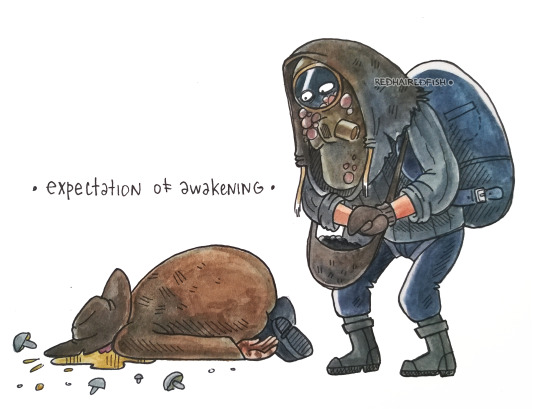
every night it’s a mushroom party
it’s okay
let’s wait
#darkwood#darkwood game#darkwood fanart#darkwood stranger#darkwood trader#acid wizard studio#horror games#body horror#traditional art#watercolor
189 notes
·
View notes
Text

Darkwood - Hero and Torch.
15 notes
·
View notes
Text

completely unnecessary horror mash-ups (20/?) - robin hood x darkwood
they thought it was a curse—and why not?
they had only curses to compare it to.
robin watched as darkness consumed sherwood forest.
it happened so slowly that perhaps a year had gone by before he realized: this is wrong. something is wrong.
it was like a disease.
had it not been for marian, he would have lost all hope.
“we’ll find a way to cleanse the forest. we’ll find a way to save our home.”
mini mix: anson seabra, robin hood + blink 182, edging + rag n bone man, human
#robin hood#darkwood#acid wizard studio#disney#william langland#horror#survival horror#horror mash-ups#crossover#au concepts
12 notes
·
View notes
Text
it's look who it is (acid)

#art#artists on tumblr#my art#original#digital art#small artist#science fantasy#sci fantasy#hazmat#wizard#hazmage#oc#sona#my sona#hazmat wizard#ttrpg art#lancer rpg#pathfinder 2e#sci fi#fantasy#wizardposting#The Wizard#original character#acid sona#acid#doodle#clip studio paint#body posititivity
12 notes
·
View notes
Text
youtube
DARKWOOD FANS RIIIIIIIIISEEEEEE
#darkwood#horror#horror game#acid wizard studios#🤖#THIS IS MY FAVORITE GAME IN THE WORLD PLEAAAASEEEE WATCH#Youtube
8 notes
·
View notes
Text
Has the darkwood fandom heard about Acid Wizard's latest project yet? It's called soccer kids and it looks absolutely adorable (///O v O)
4 notes
·
View notes
Text
About Me

Name: Al /Ali
Age: 34
Cisgender
Sign: Taurus
Pronouns: she/her
Goth
Aromantic
Neurodivergent (ADHD, APD, anxiety)
Agnostic



-This is a SIDE BLOG. I will follow you with my main (nivekogresimp)
DNI if you're:
A TERF or SWERF (or just transphobic and against sex work in general)
racist
homophobic
a fascist/nazi
pro-police
hardcore Christian
misogynistic
TCC/a Columbiner
into pedophilia/ a MAP (or if you like Lolicon/shota or DD/LG)
Ableist
Also don’t even bother following me if you’re a zionist/Israel supporter
-I post NSFW stuff sometimes, so minors should take note.
-If you see something (artwork, a photo) that belongs to you, please let me know so I can credit you or remove it.

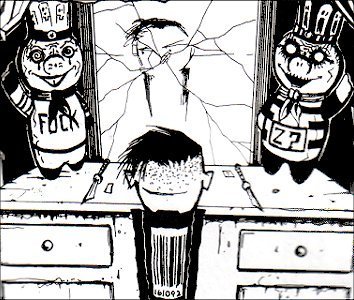
What I'm mainly interested in:
The Goth subculture/ trad goth stuff
Music in general (I love Industrial Music, Experimental, Noise Music/Harsh Noise Wall, Goth Rock, Post-Punk, Punk Rock, Grindcore, Doom Metal, all kinds of Electronic Music, 80s New Wave/Synthpop, City Pop, 90s/80s Hip-Hop and a whole bunch of other genres)
Skinny Puppy
The 1980s
Horror Movies
JTHM (and Invader Zim...sometimes)
Art & graphic design
Dark/horror/ gothic/religious aesthetic posts
goth fashion
Vampires
Cemeteries
Bones
Leftist/democratic socialist stuff
bats, cats & rats :D
Anime (Berserk, NGE, Cowboy Bebop, Sailor Moon, Hellsing, Studio Ghibli, etc.)
Cartoons
Batman
Little Nemo In Slumberland (the comic strip)
Mythology (Norse, Greek & Egyptian mainly)
Elvira, Mistress of The Dark
The Addams Family
Edward Gorey

Some of my favorite bands/artists:
Skinny Puppy, Godflesh, Tom Waits, Einsturzende Neubauten, Meat Beat Manifesto, Coil, The Cure, Front 242, Bauhaus, Siouxsie And The Banshees, Severed Heads, Alien Sex Fiend, Acid Bath, Throbbing Gristle, Cabaret Voltaire, Depeche Mode, Japan, Tears For Fears, Type O Negative, Clan Of Xymox, Virgin Prunes, Cocteau Twins, Aphex Twin, Boards Of Canada, Massive Attack, Autechre, Merzbow, Agent Side Grinder, The Klinik, (old) Ministry, Nine Inch Nails, (old) KMFDM, Front Line Assembly, Fad Gadget, Revolting Cocks, SPK, Clock DVA, :wumpscut:, Christian Death (Rozz only), Swans, The Sisters Of Mercy, Joy Division, Dead Can Dance, Sleep, Black Sabbath (with Ozzy only), Electric Wizard, Neurosis, Cult of Luna, Isis, Ningen Isu, Yoko Kanno, Church Of Misery, Bongzilla, Phobia, Doom, Pink Floyd, Altar De Fey, TR/ST, Boy Harsher, George Clanton, Ulver, Kraftwerk, Dissecting Table, Anaal Nathrakh, Lycia, Tim Hecker, Akira Yamaoka, Deftones, Porcupine Tree, Hello Meteor, The Devil & The Universe, Wardruna, Goldie
Current favorite bands/artists ATM:
Jim Kirkwood. Klaus Schulze. Severed Heads
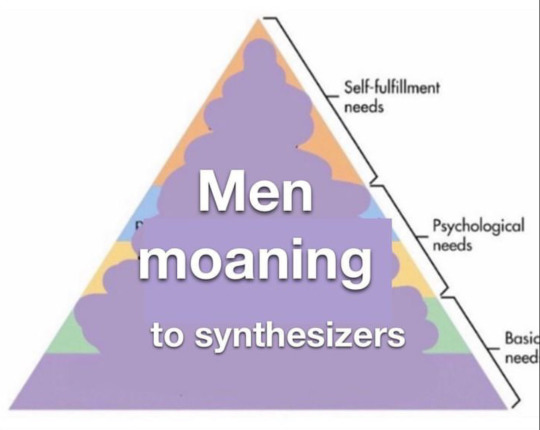


82 notes
·
View notes
Text
How’d They Do That?
Special Effects & Stunts of Silent Cinema - Part 1
This is the first installment of an open-ended series where I try to highlight and illustrate the work of special effects and stunt artists of silent filmdom. Using articles from contemporary fan and trade magazines, I’ll make gifs or dig up images and/or video clips to accompany the descriptions of how the sequences were executed.
My notations will be bracketed and highlighted in a different color. Hope you all enjoy! Fair warning: this is a long read.
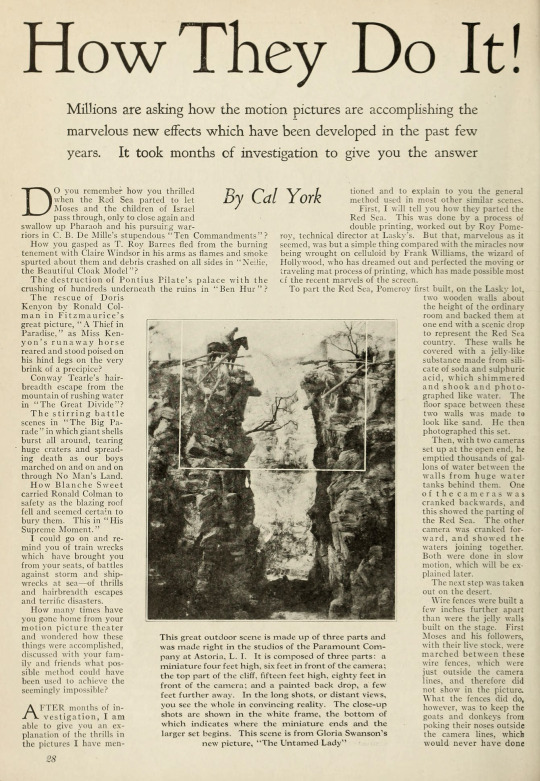
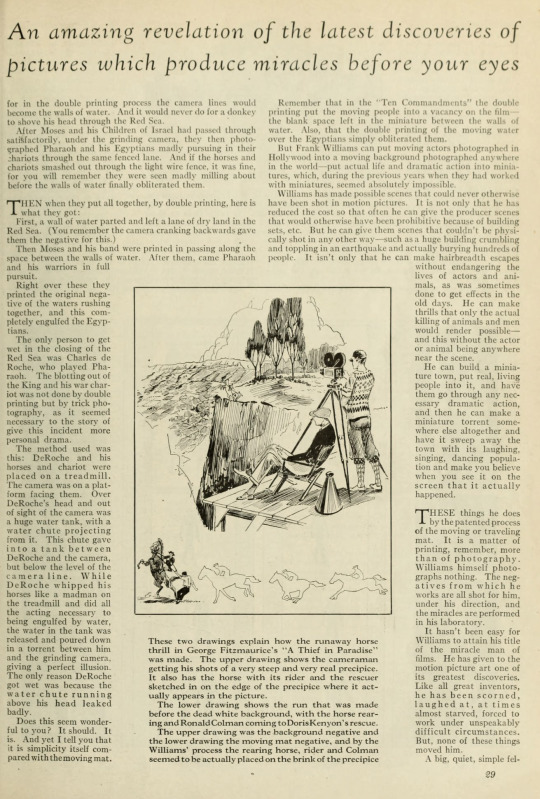
How They Do It!
[from Photoplay, April 1926]
by Cal York
Millions are asking how the motion pictures are accomplishing the marvelous new effects which have been developed in the past few years. It took months of investigation to give you the answer
DO you remember how you thrilled when the Red Sea parted to let Moses and the children of Israel pass through, only to close again and swallow up Pharaoh and his pursuing warriors in C.B. De Mille's stupendous "Ten Commandments" ?
How you gasped as T. Roy Barnes fled from the burning tenement with Claire Windsor in his arms as flames and smoke spurted about them and debris crashed on all sides in "Nellie, the Beautiful Cloak Model"?
The destruction of Pontius Pilate's palace with the crushing of hundreds underneath the ruins in "Ben Hur"?
The rescue of Doris Kenyon by Ronald Colman in Fitzmaurice's great picture, "A Thief in Paradise," as Miss Kenyon's runaway horse reared and stood poised on his hind legs on the very brink of a precipice?
Conway Tearle's hair-breadth escape from the mountain of rushing water in "The Great Divide"?
The stirring battle scenes in "The Big Parade" in which giant shells burst all around, tearing huge craters and spreading death as our boys marched on and on and on through No Man's Land.
How Blanche Sweet carried Ronald Colman to safety as the blazing roof fell and seemed certain to bury them. This in "His Supreme Moment."
I could go on and remind you of train wrecks which have brought you from your seats, of battles against storm and shipwrecks at sea—of thrills and hairbreadth escapes and terrific disasters.
How many times have you gone home from your motion picture theater and wondered how these things were accomplished, discussed with your family and friends what possible method could have been used to achieve the seemingly impossible?
AFTER months of investigation, I am able to give you an explanation of the thrills in the pictures I have mentioned and to explain to you the general method used in most other similar scenes.
First, I will tell you how they parted the Red Sea. This was done by a process of double printing, worked out by Roy Pomeroy, technical director at Lasky's. But that, marvelous as it seemed, was but a simple thing compared with the miracles now being wrought on celluloid by Frank Williams, the wizard of Hollywood, who has dreamed out and perfected the moving or traveling mat process of printing, which has made possible most of the recent marvels of the screen.
[Roy Pomeroy was head technical wizard for Famous Players-Lasky/Paramount (that is to say, he was their head special-effects engineer). We only know for certain about a handful of films that Pomeroy made specific contributions to, like The Ten Commandments (1923) and Wings (1927). As with many journeymen of the silent/studio era of Hollywood, the amount of films Pomeroy worked on was likely substantial, but many technical roles went uncredited at the time.]
To part the Red Sea, Pomeroy first built, on the Lasky lot, two wooden walls about the height of the ordinary room and backed them at one end with a scenic drop to represent the Red Sea country. These walls he covered with a jelly-like substance made from silicate of soda and sulphuric acid, which shimmered and shook and photographed like water. The floor space between these two walls was made to look like sand. He then photographed this set.

Then, with two cameras set up at the open end, he emptied thousands of gallons of water between the walls from huge water tanks behind them. One of the cameras was cranked backwards, and this showed the parting of the Red Sea. The other camera was cranked forward, and showed the waters joining together. Both were done in slow motion, which will be explained later.

The next step was taken out on the desert.
Wire fences were built a few inches further apart than were the jelly walls built on the stage. First Moses and his followers, with their live stock, were marched between these wire fences, which were just outside the camera lines, and therefore did not show in the picture. What the fences did do, however, was to keep the goats and donkeys from poking their noses outside the camera lines, which would never have done for in the double printing process the camera lines would become the walls of water. And it would never do for a donkey to shove his head through the Red Sea.
After Moses and his Children of Israel had passed through satisfactorily, under the grinding camera, they then photographed Pharaoh and his Egyptians madly pursuing in their chariots through the same fenced lane. And if the horses and chariots smashed out through the light wire fence, it was fine. for you will remember they were seen madly milling about before the walls of water finally obliterated them.
THEN when they put all together, by double printing, here is what they got:
First, a wall of water parted and left a lane of dry land in the Red Sea. (You remember the camera cranking backwards gave them the negative for this.)
Then Moses and his band were printed in passing along the space between the walls of water. After them, came Pharaoh and his warriors in full pursuit.
Right over these they printed the original negative of the waters rushing together, and this completely engulfed The Egyptians.

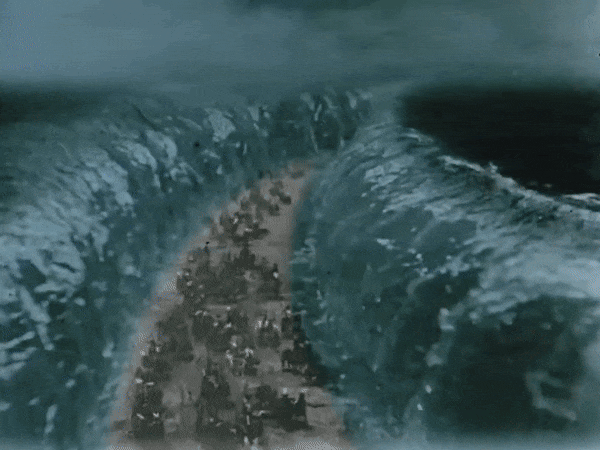
The only person to get wet in the closing of the Red Sea was Charles de Roche, who played Pharaoh. The blotting out of the King and his war chariot was not done by double printing but by trick photography, as it seemed necessary to the story of give this incident more personal drama.

The method used was this: DeRoche and his horses and chariot were placed on a treadmill. The camera was on a platform facing them. Over DeRoche's head and out of sight of the camera was a huge water tank, with a water chute projecting from it. This chute gave into a tank between DeRoche and the camera, but below the level of the camera line. While DeRoche whipped his horses like a madman on the treadmill and did all the acting necessary to being engulfed by water, the water in the tank was released and poured down in a torrent between him and the grinding camera, giving a perfect illusion. The only reason DeRoche got wet was because the water chute running above his head leaked badly.
Does this seem wonderful to you? It should. It is. And yet I tell you that it is simplicity itself compared with the moving mat.
Remember that in the "Ten Commandments" the double printing put the moving people into a vacancy on the film—the blank space left in the miniature between the walls of water. Also, that the double printing of the moving water over the Egyptians simply obliterated them.
READ ON BELOW the JUMP!
---
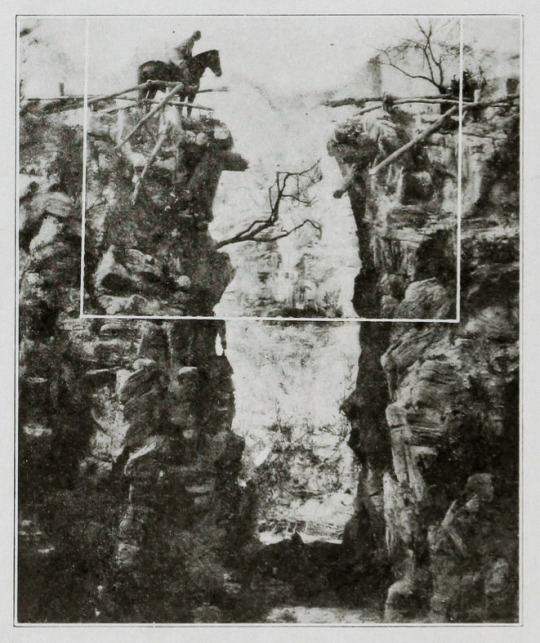
Photo caption: This great outdoor scene is made up of three parts and was made right in the studios of the Paramount Company at Astoria, L.I. It is composed of three parts: a miniature four feet high, six feet in front of the camera; the top part of the cliff, fifteen feet high, eighty feet in front of the camera; and a painted back drop, a few feet further away. In the long shots, or distant views, you see the whole in convincing reality. The close-up shots are shown in the white frame, the bottom of which indicates where the miniature ends and the larger set begins. This scene is from Gloria Swanson's new picture, "The Untamed Lady"
[The Untamed Lady (1926) is presumed lost, but luckily, a few images of this cliff-top sequence have survived.
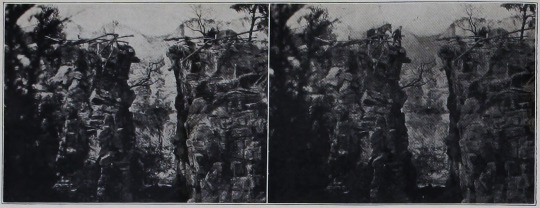

from Exhibitors Herald, 20 March 1926]
An amazing revelation of the latest discoveries of pictures which produce miracles before your eyes
---
But Frank Williams can put moving actors photographed in Hollywood into a moving background photographed anywhere in the world—put actual life and dramatic action into miniatures, which, during the previous years when they had worked with miniatures, seemed absolutely impossible.
[As you can gather from this article Frank Williams was a pioneer cinematographer and special effects artist. Williams was able to patent his moving matte process (and named it the Williams process) and it was an important effects technique used in film as as varied as Ben-Hur (1925), Sunrise: A Song of Two Humans (1926), The Lost World (1925), and The Invisible Man (1933). All of which are extant and easily accessible!
While it wasn’t in regular use for very long, the process was the basis for significant later developments in special effects photography, like green screening!]
Williams has made possible scenes that could never otherwise have been shot in motion pictures. It is not only that he has reduced the cost so that often he can give the producer scenes that would otherwise have been prohibitive because of building sets, etc. But he can give them scenes that couldn't be physically shot in any other way—such as a huge building crumbling and toppling in an earthquake and actually burying hundreds of people. It isn't only that he can make hairbreadth escapes without endangering the lives of actors and animals, as was sometimes done to get effects in the old days. He can make thrills that only the actual killing of animals and men would render possible—and this without the actor or animal being anywhere near the scene.
He can build a miniature town, put real, living people into it, and have them go through any necessary dramatic action, and then he can make a miniature torrent somewhere else altogether and have it sweep away the town with its laughing, singing, dancing population and make you believe when you see it on the screen that it actually happened.
THESE things he does by the patented process of the moving or traveling mat. It is a matter of printing, remember, more than of photography. Williams himself photographs nothing. The negatives from which he works are all shot for him, under his direction, and the miracles are performed in his laboratory.
It hasn't been easy for Williams to attain his title of the miracle man of films. He has given to the motion picture art one of its greatest discoveries. Like all great inventors, he has been scorned, laughed at, at times almost starved, forced to work under unspeakably difficult circumstances. But, none of these things moved him.
A big, quiet, simple fellow, only thirty-two years old. Shy, rather diffident of speech, he makes everything he does look easy. When he comes on a set, his quiet presence is scarcely noticed, and cameramen and technical experts go on spluttering and arguing, and when he is finally appealed to, he settles the problem so simply that everyone wonders why he didn't think of it himself.
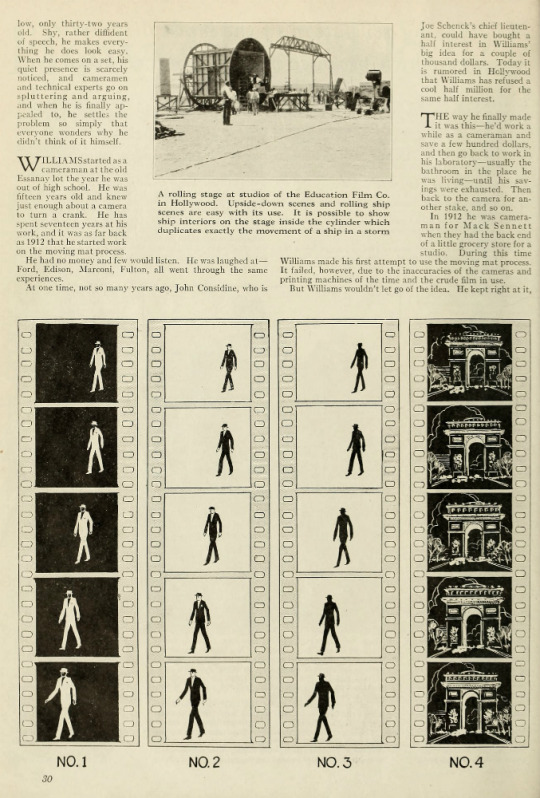
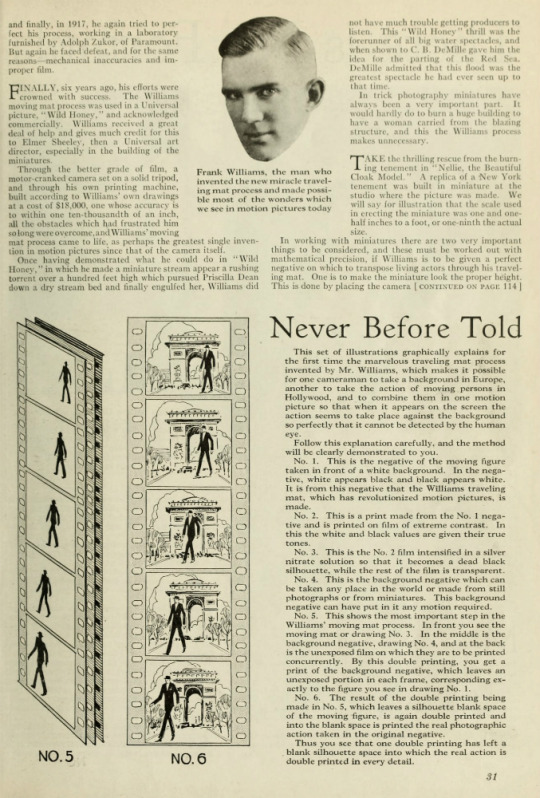
WILLIAMS started as a cameraman at the old Essanay lot the year he was out of high school. He was fifteen years old and knew just enough about a camera to turn a crank. He has spent seventeen years at his work, and it was as far back as 1912 that he started work on the moving mat process.
He had no money and few would listen. He was laughed at—Ford, Edison, Marconi, Fulton, all went through the same experiences.
At one time, not so many years ago, John Considine, who is Joe Schenck's chief lieutenant, could have bought a half interest in Williams' big idea for a couple of thousand dollars. Today it is rumored in Hollywood that Williams has refused a cool half million for the same half interest.
THE way he finally made it was this—he'd work a while as a cameraman and save a few hundred dollars, and then go back to work in his laboratory—usually the bathroom in the place he was living—until his savings were exhausted. Then back to the camera for another stake, and so on.
In 1912 he was cameraman for Mack Sennett when they had the back end of a little grocery store for a studio. During this time Williams made his first attempt to use the moving mat process. It failed, however, due to the inaccuracies of the cameras and printing machines of the time and the crude film in use.
But Williams wouldn’t let go of the idea. He kept right at it, and finally, in 1917, he again tried to perfect his process. working in a laboratory furnished by Adolph Zukor, of Paramount. But again he faced defeat, and for the same reasons—mechanical inaccuracies and improper film.
---
Photo caption: A rolling stage at studios of the Education Film Co. in Hollywood. Upside-down scenes and rolling ship scenes are easy with its use. It is possible to show ship interiors on the stage inside the cylinder which duplicates exactly the movement of a ship in a storm
[The rolling stage was used for lots of imaginative and comedic sequences in shorts and features. In the Lupino Lane short Movieland (1926), there’s a bit that shows the stage in action. Here’s a link to that specific scene, but the whole short is a lot of wacky fun and I recommend watching the full film!
Another illustration of how the rolling stage can be put to use is in When the Clouds Roll By (1919):
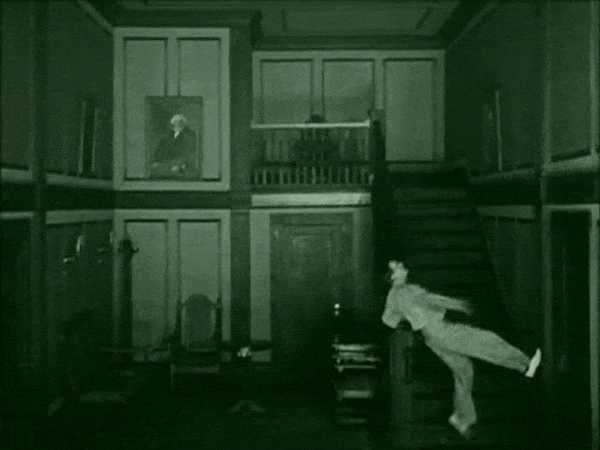

---
FINALLY, six years ago, his efforts were crowned with success. The Williams moving mat process was used in a Universal picture, "Wild Honey," and acknowledged commercially. Williams received a great deal of help and gives much credit for this to Elmer Sheeley, then a Universal art director, especially in the building of the miniatures.
Through the better grade of film, a motor-cranked camera set on a solid tripod, and through his own printing machine, built according to Williams' own drawings at a cost of $18,000, one whose accuracy is to within one ten-thousandth of an inch, all the obstacles which had frustrated him so long were overcome and Williams' moving mat process came to life, as perhaps the greatest single invention in motion pictures since that of the camera itself.
Once having demonstrated what he could do in "Wild Honey," in which he made a miniature stream appear a rushing torrent over a hundred feet high which pursued Priscilla Dean down a dry stream bed and finally engulfed her, Williams did not have much trouble getting producers to listen. This "Wild Honey" thrill was the forerunner of all big water spectacles, and when shown to C.B. DeMille gave him the idea for the parting of the Red Sea. DeMille admitted that this flood was the greatest spectacle he had ever seen up to that time.
[Unfortunately, Wild Honey (1922) is currently presumed lost and I was unable to find any depiction of Priscilla Dean fleeing from a torrent of water. As noted above however, there are quite a few extant films that also used Williams’ moving matte process.
In case you were wondering, I put $18,000 through an inflation calculator and it is equivalent to more than $315,000 in 2023 money!]
In trick photography miniatures have always been a very important part. It would hardly do to burn a huge building to have a woman carried from the blazing structure, and this the Williams process makes unnecessary.
TAKE the thrilling rescue front the burning tenement in "Nellie, the Beautiful Cloak Model." A replica of a New York tenement was built in miniature at the studio where the picture was made. We will say for illustration that the scale used in erecting the miniature was one and one-half inches to a foot, or one-ninth the actual size.
In working with miniatures there are two very important things to be considered, and these must be worked out with mathematical precision, if Williams is to be given a perfect negative on which to transpose living actors through his traveling mat. One is to make the miniature look the proper height. This is done by placing the camera the proper distance from the miniature (of course much closer than if it were a real building), and shooting from a lower level. The other is called timing. For example, if a miniature tree is to fall and the camera set-up is close enough and low enough to give the miniature the proper height when it is seen on the screen, then you must be careful of the speed with which it falls.
A little tree falls rapidly—a big tree slowly. And here is where the timing enters. Ultra speed cameras are used. The faster you crank the more pictures you get per second, and the slower the thing seems to move when you see it on the screen. You have all seen slow-motion pictures. These were made with slow-motion cameras, or what are more commonly termed ultra-speed cameras. And it is through this slow motion photography that the little tree is made to fall at the proper speed to be the big tree it represents, or the miniature stream is made to run at the proper speed for a giant river.
And so to get back to the fire which is still threatening "Our Nell." A torch is applied to the miniature tenement. At the proper count little invisible wires tied to window sashes are pulled and burning brands crash to the street below. And all the time the cameras, driven by motors at the proper speed, placed at the right distance from the conflagration and almost flat on the floor, are grinding away and recording this great fire.
[Nellie, the Beautiful Cloak Model (1924) is extant, with a print located at Gosfilmofond, but the film is not readily accessible. However, a depiction of the burning building sequence appears on an advertisement for the film:

from Film Daily, 28 February 1924]
OVER on some other part of the lot, and at any time which suits the director's convenience, T. Roy Barnes, with Miss Windsor in his arms, dashes through a black velvet door and down a street backed with more black velvet.
Two things must be remembered, however. The actors must come out of the velvet door at the right spot and at the right time or "count." This is necessary so that Williams can match up the fire negative, which is the background with action in it, with the negative of Miss Windsor and Barnes, which becomes the moving mat.
The remainder is simple, and is done by Williams and his printing process over at his laboratory.
On the screen you see Barnes dashing from a burning tenement with Miss Windsor in his arms while, in reality, neither of the actors has been close enough to a fire to singe a single eyelash.
Blanche Sweet's rescue of Colman in "The Supreme Moment" was worked out in the same manner as this, as have been most other burning building thrills in pictures made in the last few years.
[His Supreme Moment (1925) is presumed lost and unfortunately I was unable to locate a depiction of the burning building rescue mentioned here.]
Now for the destruction of Pontius Pilate's palace with the struggling mass crushed beneath, in "Ben Hur." Of course the palace was done in miniature, while the people did their acting out on the lot, where the street was built with a dead white backing. Again the timing had to correspond with that in the falling of the palace.
The throng of people was lined up and rehearsed. Two lines were drawn in the street a fixed distance apart—which represented the space where the ruins of the palace would fall, and the throng was sent dashing wildly down the street. At a fixed signal, all caught between the two marks fell flat on the ground. Those who had not reached the first line halted and registered terror. Those who had passed the second mark fled on, looking back and also registering terror. You see, those caught between the two marks were the people buried under the debris of Pilate's palace—those on either side had escaped.

Then came the trick printing with the two negatives, with considerable painting out of those who had fallen flat between the two lines, and you have the palace falling on the panic-stricken throng in the street. The accompanying drawings will help you to visualize this.
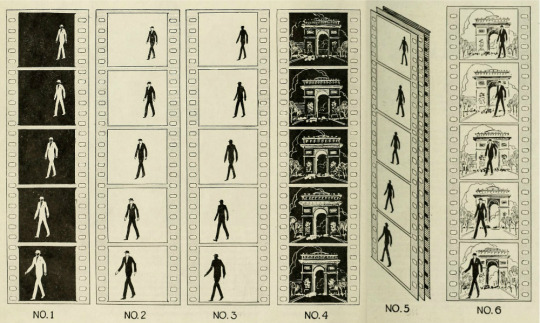
Never Before Told
This set of illustrations graphically explains for the first time the marvelous traveling mat process invented by Mr. Williams, which makes it possible for one cameraman to take a background in Europe, another to take the action of moving persons in Hollywood, and to combine them in one motion picture so that when it appears on the screen the action seems to take place against the background so perfectly that it cannot be detected by the human eye.
Follow this explanation carefully, and the method will be clearly demonstrated to you.
No. 1. This is the negative of the moving figure taken in front of a white background. In the negative, white appears black and black appears white. It is from this negative that the Williams traveling mat, which has revolutionized motion pictures, is made.
No. 2. This is a print made from the No. 1 negative and is printed on film of extreme contrast. In this the white and black values are given their true tones.
No. 3. This is the No. 2 film intensified in a silver nitrate solution so that it becomes a dead black silhouette, while the rest of the film is transparent.
No. 4. This is the background negative which can be taken any place in the world or made from still photographs or from miniatures. This background negative can have put in it any motion required.
No. 5. This shows the most important step in the Williams' moving mat process. In front you see the moving mat or drawing No. 3. In the middle is the background negative, drawing No. 4, and at the back is the unexposed film on which they are to be printed concurrently. By this double printing, you get a print of the background negative, which leaves an unexposed portion in each frame, corresponding exactly to the figure you see in drawing No. 1.
No. 6. The result of the double printing being made in No. 5, which leaves a silhouette blank space of the moving figure, is again double printed and into the blank space is printed the real photographic action taken in the original negative.
Thus you see that one double printing has left a blank silhouette space into which the real action is double printed in every detail.
---
The rescue of Doris Kenyon, which is also illustrated by the artist, was accomplished in this manner. One negative was shot of a very real and very steep precipice, the cameramen suspended on a platform far out over the edge to get the proper angle. Another negative was shot of Miss Kenyon's horse racing madly along what looked like a fence—but what was the inevitable white drop. Doris and the horse had to reach a certain mark at a certain count—for over at the precipice there had been rocks and dirt released at a certain count—the horse bad to rear, and Colman had to reach the frenzied beast, starting from outside the camera line, and he, too, must arrive on the right count. There could be no waiting for man or horse. They took it perhaps forty times before everything was exactly right, and then the two negatives (the precipice background and the moving mat) were ready for the printing wizard, and audiences got a great thrill.
[A Thief in Paradise (1925) is almost entirely lost. I profiled the film in my series Lost, but Not Forgotten in 2023.]
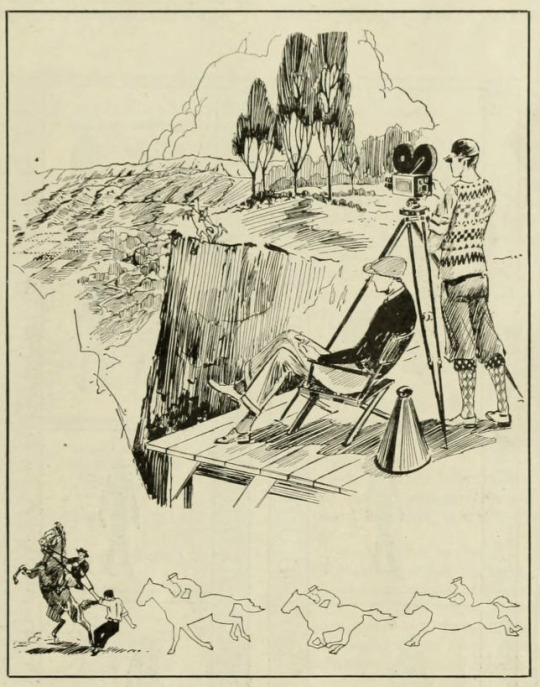
Photo caption: These two drawings explain how the runaway horse thrill in George Fitzmaurice's "A Thief in Paradise" was made. The upper drawing shows the cameraman getting his shots of a very steep and very real precipice. It also has the horse with its rider and the rescuer sketched in on the edge of the precipice where it actually appears in the picture.
The lower drawing shows the run that was made before the dead white background, with the horse rearing and Ronald Colman coming to Doris Kenyon's rescue.
The upper drawing was the background negative and the lower drawing the moving mat negative, and by the Williams' process the rearing horse, rider and Colman seemed to be actually placed on the brink of the precipice
---
You remember the mountain of water pursuing Conway Tearle in "The Great Divide." Of course they shot the torrent in miniature. Conway and his horse made their hairbreadth dash on a dark night and in an artificial rainstorm with nothing but a director threatening —then, although they did have quite a time making the steed climb a slippery and sloping wooden bridge, which was out on the back lot. Then up in Mr. Williams' laboratory, they finished one of the greatest thrills ever witnessed.
[While The Great Divide (1925) is thankfully extant at Cinemateket-Svenska Filminstitutet, it’s not easily accessible and I was unable to find a depiction of the effect.]
And the marvelous battle scenes in "The Big Parade." There were the big guns tearing huge craters in No Man's Land made on one negative, and the boys marched on and on and on in the other negative, and Mr. Williams brought them together in his printing laboratory. However, it was by no means as easy as it sounds, for this was one of the hardest pieces of moving mat printing ever accomplished.

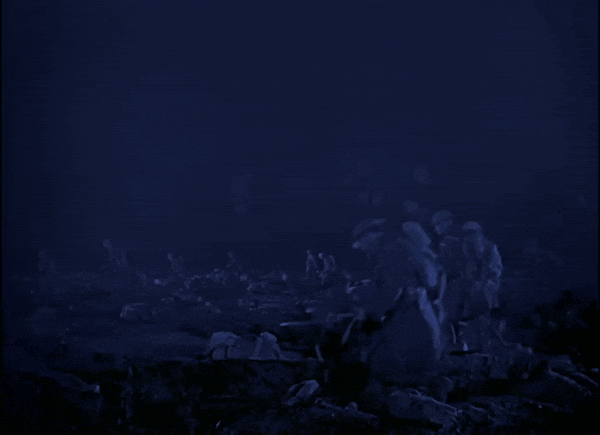

SO critical is the public that the building, photographing and printing of these miniatures must be of the very highest type of workmanship obtainable. It might be interesting to know that this work in "The Big Parade" alone cost approximately $70,000 for the background negative and the moving mat negative. The miniature battlefield was about one hundred thirty-five feet long and more than seven thousand miniature shells were fired in a period of forty seconds.
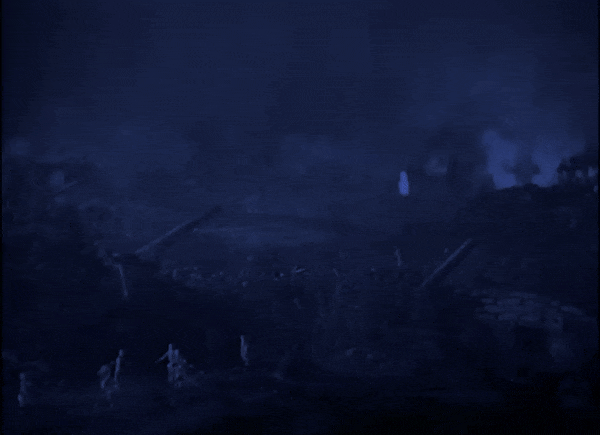



On another picture—"The Barrier"—which shows a fierce storm at sea, icebergs, and a ship caught and crushed in an ice floe, more than $85,000 have been spent to create these illusions.
[The Barrier (1926) is unfortunately presumed lost and I wasn’t able to find a depiction of this effect.]
Mr. Waller, technical camera expert of the Famous Players Long Island Studio, had never seen a cyclone; yet he was instructed to produce one for D. W. Griffith's picture, "That Royle Girl." Mr. Waller did extensive research work on the subject, and then made one to experiment with. A scientific knowledge of the working of the law of gravity, by the way, is necessary to create this phenomenon of nature.
[That Royle Girl (1925) is also presumed lost, and without film footage of this sequence there’s not really a way to know how the cyclone looked in the film. However, I do think the image highlighted in the advertisement below is likely from the cyclone sequence.
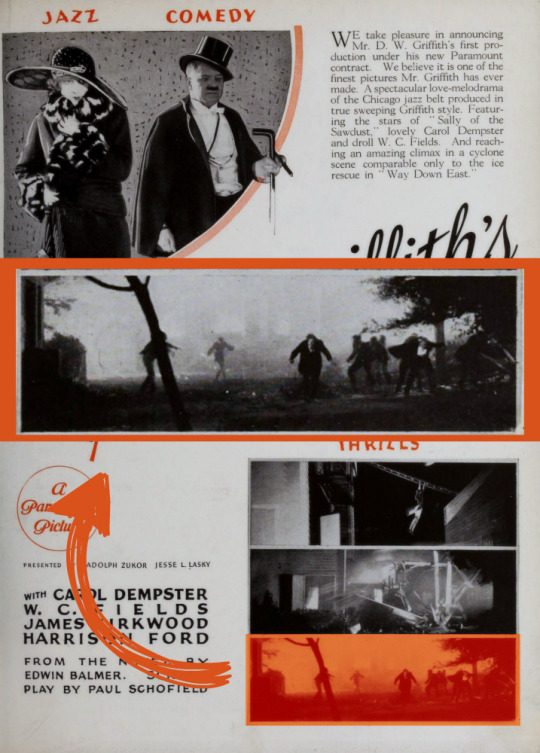
from Motion Picture News, 21 November 1925]
In the basement of the studio Mr. Waller connected up three vacuum cleaners. With three suctions of air and some dust, he made a tiny cyclone. This was photographed in slow motion so that the camera and technical crew might study the formation and activity of the cone.
From his observations of the film, Mr. Waller was able to prepare the series of wash drawings which, photographed in animated cartoon fashion, represented the action of the cyclone's cone in this sequence of the picture.
Several hundred drawings had to be made, each one depicting gradually the advance of the cone toward the Inn, which it finally demolishes. These were photographed in rotation on motion picture negative, and this negative double exposed on the 180-foot miniature scene containing the houses and trees. Thus we got a very good illusion of the cone of a cyclone advancing over a village and sweeping houses and trees out of its path.
[I wonder if/hope that some of these drawings have survived!]
The animated cartoon idea was also used in "A Kiss for Cinderella," when the pumpkin and mice change into the coach and four. The first few feet of the sequence showed real mice and pumpkin; from then on 256 wash drawings of the gradual transformation were photographed in rotation and gave the impression of being animated.
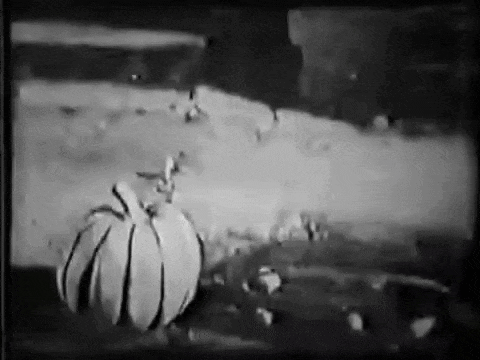
Double exposures of one actor playing two parts is the oldest and most familiar camera trick to the fans.
Just recently, however, has it been perfected to the point where the actor's two screen shadows can light each other's cigarettes and shake hands.
Tom Meighan, you recall, did this in Irish Luck."
AN invisible line from top to bottom divides each frame of the negative in half. One half at a time is exposed, photographing one half of the set.
Tom appears as Lord Fitzhugh on the left half, and as Tom Donohue on the right half. If you remember. Tom's two shadows are sitting side by side on a divan in the instance of the cigarette lighting. Fitzhugh leans over and gets a light from Donahue's cigarette. The illusion is perfect. But the cigarette from which his lordship really got the light was tacked onto a chair just outside the line, on the half of the set not being photographed at that moment. Only the lighted end of the cigarette projects into Fitzhugh's half of the picture.
[Irish Luck (1925) is extant at Eastman House, but it’s not currently easily accessible. I wasn’t able to find a depiction of this split-screen effect.]
Then when Donahue's half of the scene was being filmed, Tom leans forward and holds his cigarette in exactly the spot where the chair had been, the lighted end being outside his half of the picture. Think of the perfect matching this requires!
It is done this way. As Lord Fitzhugh performs on one side of the set, the director times his actions, counting the seconds out loud. He knows just where his lordship's right arm is, for instance, at the sixteenth second. When Donahue begins to perform on the other side of the set, his arm must be in a corresponding position at the sixteenth second. Tricky.
A thrilling moment in "Aloma of the South Seas," Gilda Grey's new picture, occurs when a shark eats a sailor. If you want this thrill, you naturally have to take it synthetic.
The shark cost $3,000. It was made of flexible rubber, and its insides consisted of a maze of electric wiring. Outside the body were several buttons which the actor could operate in his fight with the shark. It swims, wiggles its tail and bites electrically.
[Aloma of the South Seas (1926) is presumed lost and I wasn’t able to find images of the shark described here. However, as consolation, here is a photo from American Cinematographer of the film’s cinematographer Harry Fishbeck shooting on location in Puerto Rico:
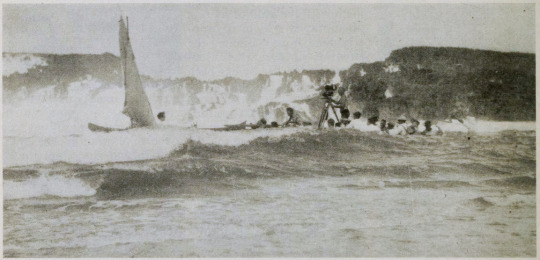
from American Cinematographer, February 1926]
I guess most of the suffering for art is done by the actors who tie themselves into knots to create the illusion of paralysis, amputated legs and so on. John Gilbert is shown in the last reels of "The Big Parade" with an amputated leg. Jack Barrymore in "The Sea Beast," also does it. It is merely a painful process of strapping the foreleg back. In "The Street of Forgotten Men," with Percy Marmont, a very lucid expose of cripple fakes is shown. Marmont had his arm strapped to his back for hours at a stretch during the filming of this picture. It hurts the first fifteen minutes, Percy said. After that the arm becomes numb.
A vigorous massage is necessary to bring it back to life, but it doesn't feel normal for weeks, Percy says.
Lon Chaney has his tricks of deformity down so pat that they are almost painless to him now.
#1920s#1910s#1926#classic film#classic movies#film#american film#my edits#silent film#my gifs#silent movies#silent era#silent cinema#cinema#film history#history#Roy Pomeroy#Frank Williams#Film Art#How'd They Do It#photoplay#lantern
60 notes
·
View notes
Text
The Art of Putting on Horror Ambiance in Order to Emulate Getting Hunted for Sport, in Hopes that the Adrenaline Produced Forces You to Lock In
Not to brag, but my attention span is pretty miserable. Even things I genuinely enjoy doing are shoved to the side and neglected in the favor of doing actually, literally nothing.
Knowing this fact about me then, it may come as no surprise that getting myself to do schoolwork is an actual herculean task that I either have to trick myself into doing somehow; or as it ends up being in most cases, have to be forced into doing by my own debilitating fear of the due date, now only one night's sleep away, and its consequences on my GPA.
Maybe this sense of fear, this sense of myself in direct opposition to an impending aftermath, is why having horror game OST's playing in my ears when I'm writing is so effective. Misery loves company.
"Anyone else hiding in the comments right now?"
I don't actually have an extensive history of playing horror games-- instead, my knowledge comes from watching them at probably too young an age on YouTube.
My main sources of horror game content came from Markiplier-- of course-- and a much smaller youtuber that at the time when I first watched him eleven years ago, went by Harshly Critical, but now goes by John Wolfe. Both men have played an extensive amount of indie horror games-- some good, and some really, really bad, and some just completely mediocre and forgettable-- and I watched them all. Or at least my fair share of them.


Baby's First Horror Game
The first horror game that I ever personally played, and actually beat instead of turning it off at the first sign of terror, was a game called Darkwood, officially released in 2017 by Acid Wizard Studio.
I didn't even play it off one of their recommendations either-- I had no idea this game existed in any capacity until one day in 2020 when I was scrolling through the Play Station Store, specifically looking for interesting horror games to try.
The first thing about the game that grabbed me was the horrific (in the best way) cover art, but what got me to actually buy the game and play it was its insistence on the minimal presence of jump scares--



At the time, and after the commercial success of Five Nights at Freddy's and its multiple sequels, a series whose staple was the jump scare; many horror game consumers became soured to that convention of the genre-- often calling them out as "cheap" and "out of nowhere lazy bullshit". This sentiment among the community was evidently common enough to be able to market one's game off of. I do remember thinking it was a bit pretentious-- giving off a major "I'm different from other horror games" feel-- but I guess it worked. because I did in fact purchase the game.
And they were absolutely in their right to claim their game as "an atmospheric horror experience that creates a feeling of tension without cheap horror tricks."
Dull of One Sense Sharpens Another
Despite the art on the cover, the actual game itself is pixelated-- for the most part. In fact, the only times when you aren't in immediate danger is when you're sat across from characters that look like this:



That is exactly what makes the sound and music design so genius though; it's that importance of it, that necessity. When the gameplay looks like this--

-- that is to say in a Top-Down perspective with generally dark and muddy, muffled colors; You have to listen for the threats, instead of just normally being able to see them in HD.
That's another thing too, as seen in the photo, there is a specific, defined area that is lit up where enemies can be seen. However, in the game, anything outside of that sliver of light-- anything behind you-- will not be visible until you turn around and shine your light on it. This leads to a lot of enemies inevitably sneaking up on you, and in this game's case where you have extremely limited health and stamina reserves (the red and silver bars in the top left corner), you have to learn to listen for them or else they will easily kill you.
I think then that the intense amount of focus I put into listening for sticks around me breaking, or for sounds of shuffling and growling, all on top of the general game's ambiance and soundtrack, conditioned my brain into focusing whenever the game's music plays.
The Buzzword
youtube
Darkwood, authored by Artur Kordas who had a large part in the development of the entire game, has a fantastic assortment of songs that all flow smoothly into each other-- and just they are designed to in the game, they fade into the background, providing a consistent atmosphere so that you can focus on the task at hand-- or at least so that I can.
There are also one or two songs that refuse to wash away into mood music. My favorite song on the album, "Underground", is a perfect example of this. It comes in with this slow and consistent, almost pulsating type of ragged noise, one that makes me picture an ugly, broken and dented, rusted, barely working trumpet, with an underneath layer that sounds like dragging stone against stone. Then around halfway through the song, an aggressive and exciting drum beat with hints of a metallic sound crescendos and crescendos, chasing the original set of sounds until it's all that's left-- completely overriding the grinding stone and leaving a thicker horn blare in replacement of the old one. This of course eventually fades into one of the common buzzing motifs found in many placing of the game's soundtrack, that's meant to signify safety, or hope.
This hasty, thrilling song provides a really nice break up and into the rest of the album, that is an even nicer subconscious reminder to my brain that there is danger if I do not promptly "pick up the pace" of my writing-- and further that there is safety on the "other side" of finishing my work.
Recommendations?
I have played many video games; some that have required a lot of my focus that aren't necessarily horror, but whose soundtracks really help me to concentrate; and I've played other horror games where the soundtracks end up more distracting than helpful. I've also played some games that are my favorites of all time, and I've put many, many hours into, where their soundtracks do absolutely nothing because they're just a little boring.
Darkwood is special in that way, where it lies in a neat, cohesive little combination that ends up perfectly suiting my need for background music when I write.
And I thought it was pretentious.
Does anyone else have specific videogame OST's that work like this for them? I'm always looking to discover new music, especially music that's ideal for studying and schoolwork-- and it definitely doesn't have to be horror; like I've said, I use multiple different genres of OST's to help me out.
Also, I feel like this goes without saying, but if you are looking for a horror game to play, I do recommend trying out Darkwood.
youtube
Or if you'd rather just listen to the soundtrack, I understand.
3 notes
·
View notes
Text

nice
#darkwood#darkwood game#darkwood fanart#acid wizard studio#wolfman#wolfman darkwood#horror#body horror#horror games#traditional art#watercolor#mixed media
142 notes
·
View notes
Text
POST WINTER BREAK WE HAVE BREATHED WE HAVE RESTED WE ARE READY FOR 2024
I GUESS I'M SLOW BUT SLOW AND STEADY STILL WINS SO I'M TRYING NOT TO BEAT MYSELF UP OVER IT
SLOW IN THE SENSE OF NOT ONLY AS A STUDENT OF MEDICINE BUT ALSO A STUDENT OF #LIFE LMFAO
HERE ARE MY TIME SAVING, JOY SPARKING WELLNESS LESSONS/REMINDERS FOR MYSELF AT THIS TIME THAT I WANTED TO SHARE WITH EVERYONE:
I cannot express how LAUGHABLE of a venture it was to expect myself to ever reasonably keep up with essentially a 6 days/week workout routine in the midst of the biggest life transition I'm experiencing thus far. This semester we are focusing on fitting in a 1 hour session only 2-3x/week, that hits both strength training AND cardio - the name of the game is efficiency!!! Aerobic, weight-bearing, heart-rate elevating, fat-burning, full body, FUNCTIONAL, ATHLETIC. I'm accepting that certain other goals (e.g. flexibility) will have to take a backseat for the time being. It's looking like a lot of HIIT, double compounds (e.g. squat to shoulder press), minimal equipment ->
I'm done with waiting in lines for popular machines!!! WHO HAS THE TIME!!! I've also learned the value of simplifying your needs as much as possible the so that your ability to stay consistent with your workouts is not limited to exclusive, fancy equipment that ties you down to a particular studio/gym e.g. kind of a meme but I got so used to the hip thrust machine at my giant suburban gym just to basically never see it again. I PRAY for the day I am able to rely on body weight calisthenics alone, but until then, there's so much magic in a bare-bones bench + dumbbells gym, and almost everywhere you go will have that
on that note, a lot of solidcore moves can be done with sliding discs, youre welcome
for the first time in an extremely long time, one of my primary goals this time around is actually weight loss - there's a whole lot more I can say about this but for now, one of the primary reasons is the fact that I will be in Korea for the first time ever this summer ifykyk lol. but starvation is never the means nor the ends, especially given how much GLUCOSE my brain requires during these long days. I'm approaching this as a fun challenge to see how I can be the most efficient (time and money) with my fuel
-----------
SUBPOST!!! HOW TO MAKE SALADS LESS OF A CHORE THANK ME LATER
->BUY A LARGE PLASTIC BOWL WITH A LID!! EZ TO CLEAN EZ TO SHAKE/MIX EZ TO CLEAN BC LIGHTWEIGHT
->ROMAINE (CRUNCH + FLAVORLESS) + KALE (SOFT + EARTHY) IS THE BEST LEAST BORING GREENS COMBO THATLL DELAY TEXTURAL DISINTEREST
->TRY NOODLES AS UR CARB INSTEAD OF QUINOA OR RICE BC COLD NOODLES > COLD OTHERS
->USE LITERALLY JUST ACID (LEMON OR LIME JUICE) AS UR DRESSING AND ADD HERBS/SEASONINGS/NUT BUTTERS (THINNED OUT) SEPARATELY DIRECTLY INTO THE BOWL!!!! IT ADDS THE DEPTH OF FLAVOR BUT FEELS LESS HEAVY AND ALSO LESS DISHES BC U DONT NEED TO FKN MIX UR DRESSING IN A SEPARATE CONTAINER AND IT GET IT ALL GREASY FROM OILS AND ALWAYS HAVE LEFT OVER AND NEVER USE THE LEFTOVER ASFDIAHSDFLKH
-> VIDALIA CHOP WIZARD/-ESQUE TOOLS
GL I HOPE U ARE ABLE TO EAT MORE VEGGIES THIS YEAR!!!!!
--------
snack hunt saga:
the biggest revelation = The Only Bean Edamame Beans, they have a 11g protein :110cal ratio (same ratio as those pure protein bars) and go down wayyy better bc it's real food and not processed powder (I'm still learning to tolerate protein powder). They come individually packed too so SO good for on the go!!!!
I've been liking TJ's flavored cashews too - not the best macro profile (like all nuts) but are so easy to pack for a study session and don't go bad quickly
MEDJOOL DATES every once in a while i remember again that nuggets of heaven exist and are so filling so quickly
1 note
·
View note
Text







2,112.) Darkwood
Release: July 24th, 2014 // August 17th, 2017 | GGF: Open World, Survival Horror, Action-Adventure, Exploration, RPG, Crafting, Psychological Horror, Top-Down Shooter | Developer(s): Acid Wizard Studio | Publisher(s): Acid Wizard Studio, Crunching Koala Sp. z o.o., Nippon Ichi Software, Inc. | Platform(s): Linux (2014), Macintosh (2014), Windows (2014), Nintendo Switch (2019), PlayStation 4 (2019), Xbox One (2019), Stadia (2021)
0 notes
Text
Survival horror and life story on Xbox Live Gold
Subscribers can look forward to two very different games in July. Xbox Live Gold Status (and Xbox Game Pass Ultimate). Microsoft has announced that it will be adding Games with Gold to its offering. dark wood And When the past was near.
Darkwood is scary survival horror top view from Acid Wizard studio. In a randomly generated world, you will not be held by the hand and literally everything will…

View On WordPress
#community#computer games#console games#criticism#dark wood#edition#game news#game rating#game Review#game show#grade#how are you#indian tv#let&039;s play#live broadcasts#native american#news#Nintendo Switch#PC#PlayStation 4#prefix 5#review#tv#TV show#video review#When the past was near#Xbox#Xbox Live Gold Status#Xbox One#Xbox Series X
0 notes
Text
Magic at Three Broomsticks
I haven't been to any major theme parks in over a decade, mainly because of how much they cost, from tickets alone to parking, there are so many add-on costs. The one cost that I used to hate the most is the food. Mediocre and bland food that costs as much as a fine dining experience is what I experienced as a teenager. I'm not sure when this changed, but I do recall being very impressed dining at Disney's Carthay Circle several years ago. The other major theme park, Universal Studios, has really grown over the years, and they have also stepped up their dining options.
We recently visited Universal Studios Hollywood because of their newly launched Super Nintendo World. We wanted to make a certain die-hard Super Mario fan happy and took him to experience this newest expansion, which also has a cute cafe. Unfortunately for us, we were unsuccessful in snagging a reservation, which got scooped up very quickly for the day. We opted instead to try Three Broomsticks in the Wizarding World of Harry Potter, and this turned out to be such a wise decision. First of all, no reservations. We simply walked up to the line (which was surprisingly short - perhaps a 10-minute wait) and grabbed an open table. The food was British-themed, which I typically enjoy.


The food portion was unexpectedly generous. We got Bangers and Mash and the Shepherd's Pie, split among two adults and a child. The sausages were good and savory, but I was surprised to find my favorite item on the plate was the roasted tomato. It was tart and sweet, and the acidity just cut through some of the heaviness of the rest of the plate. The Shepherd's Pie had a similar flavor profile - the cooks (or house elves?) probably used the same gravy in both dishes. Nevertheless, the slight difference in texture of the mashed potatoes in the Shepherd's Pie was good.

For dessert, we got the sticky toffee pudding, which came topped with a scoop of vanilla ice cream. So in all honesty, we actually started with eating dessert first, as the ice cream would have surely melted completely if we had not done so. Some diners went back in line to order dessert after their lunch, but we also didn't want to bother with that, which was why we ordered everything at once. The sticky toffee pudding was denser than how I make it. Theirs could have passed for a bread pudding even. The pudding was good, but not especially memorable. This was probably because we also had hot butterbeer, the signature drink from the Wizarding World/Harry Potter universe. It was quite good, but incredibly sweet. It probably stole the spotlight from the sticky toffee pudding for us. The sweet upon sweet also gave one grown up (not me) a stomach ache. My recommendation is get either the hot butterbeer or the sticky toffee pudding, but not both. Given that hot butterbeer is available exclusively at Three Broomsticks, I would lean towards the hot butterbeer. (Cold and frozen butterbeer can be found throughout the area.)
I'm not sure Three Broomsticks would do well as a standalone outside the Wizarding World, but at least within the confines of Universal Studios, this should a must-dine location even if you aren't a Potterhead. The cost was reasonable, the food was good, and the staff (at least on the day I visited) were cheerfully in character. I found this to be a charming experience and if I make it back to Universal Studios again, I would go back for some hot butterbeer.
Three Broomsticks
100 Universal City Plaza
Universal City, CA 91608
Telephone: (800) 864-8377
1 note
·
View note
Text
May Albums
How I Left You - Knifehandchop - Some kind of electronic
DISCO4 :: PART I - HEALTH - Industrial weird metal etc
The Mollusk - Ween - ??? Weird rock
Fragments - Bonobo - Some DJing stuff
The Campfire Headphase - Boards of Canada - IDM
Endtroducing - DJ Shadow - Trip Hop
Evanescence - Scorn - Industrial and Dub
Selfless - Godflesh - Industrial Metal
Lift Your Skinny Fists Like Antennas To Heaven - Godspeed You! Black Emperor - Post Rock
The Violent Sleep Of Reason - Meshuggah - Djent
1982 - Honor Role - Like Hardcore Punk with kind of almost math rock
Camofleur - Gastr Del Sol - Math Rock
Four Great Points - JUNE OF 44 - More Math Rock
Flemish Altruism - A Minor Forest - Even More Math Rock
Heaven or Los Vegas - Cocteau Twins - Dreampop
My Arms, Your Hearse - Opeth - Progressive Death Metal
In The Zone - Britney Spears - Pop
Tri Repetae - Autechre - IDM
Call Me If You Get Lost - Tyler, The Creator - Hip Hop
Paper Mâché Dream Balloon - King Gizzard & The Lizard Wizard - Folk
Life After Death - The Notorious B.I.G - Gangsta Hip Hop
This Is The Album Of A Band Called Abadesi Shank - Abadesi Shank - Some stranger math rock
Live And Cuddly - Nomeansno - kinda mathy punk
April In Paris- Count Basie - Swing
'67-'69 STUDIO et LIVE (2022 Remastered) - Les Rallizes Dénudés - Weird Experimental Psych Rock
Growing - Sleeping People - Math Rock
Beats, Rhymes & Life - A Tribe Called Quest - Jazz Hop / Acid Jazz
Burner - Breadwinner - Math Rock
Animals - TTNG - believe it or not, more math more rock
Ágætis byrjun - Sigur Rós - Experimental Rock
Diana Ross Presents The Jackson 5 - The Jackson Five - Soul
Great Annihilator - Swans - Experimental Rock
midcity - clipping. - Industrial Hip Hop
haha - The Garden - Like. If jungle, surf rock, and punk had a baby
More Skin With Milk-Mouth - Giraffes? Giraffes! - Math Rock
Absent Moon, A Hylics Song Cycle - Chuck Salamone - Psych Rock thing made for a game I really love by the composer of the actual game check out Hylics and Hylics 2 on steam also kind of musical theater sounding
What Happens After the Death Is Recorded - DJ Rozwell - Mr Wizard DJ (I still don't know what genre he is)
Atrocity Exhibition - Danny Brown - Experimental Hip Hop
Purple Onion - The Les Claypool Frog Brigade - Funk psych rock or something. Its weird
1 note
·
View note
Text
Epic Games Store: giochi del 13 ottobre 2022 disponibili
Epic Games Store: giochi del 13 ottobre 2022 disponibili
Read More Su Epic Games Store è possibile scaricare i giochi gratis della settimana, che saranno disponibili da oggi 13 ottobre al 20 ottobre 2022. Si tratta dell’horror Darkwood e di ToeJam & Earl: Back in the Groove. Darkwood è un survival horror molto particolare sviluppato da Acid Wizard Studio. In questo titolo vestiremo i panni di un uomo bloccato all’interno
Epic Games Store: giochi del 13…
View On WordPress
0 notes